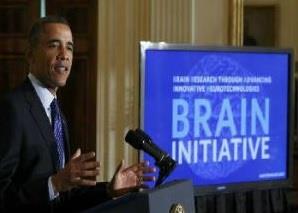April 3, 2013
WASHINGTON: President Barack Obama on Tuesday proposed an effort to map the brain's activity in unprecedented detail, as a step toward finding better ways to treat such conditions as Alzheimer's, autism, stroke and traumatic brain injuries.

April 3, 2013
WASHINGTON: President Barack Obama on Tuesday proposed an effort to map the brain's activity in unprecedented detail, as a step toward finding better ways to treat such conditions as Alzheimer's, autism, stroke and traumatic brain injuries.

Obama asked Congress to spend $100 million next year to start a project that will explore details of the brain, which contains 100 billion cells and trillions of connections.
That is a relatively small investment for the federal government – less than a fifth of what NASA spends every year just to study the sun – but it is too early to determine how Congress will react.
Obama said the so-called BRAIN Initiative could create jobs, and told scientists gathered at the White House that the research has the potential to improve the lives of billions of people worldwide.
"As humans we can identify galaxies light-years away," Obama said. "We can study particles smaller than an atom, but we still haven't unlocked the mystery of the three pounds of matter that sits between our ears."
Scientists unconnected to the project praised the idea.
BRAIN stands for Brain Research through Advancing Innovative Neurotechnologies. The idea, which Obama first proposed in his State of the Union address, would require the development of new technology that can record the electrical activity of individual cells and complex neural circuits in the brain "at the speed of thought," the White House said.
Obama wants the initial $100 million investment to support research at the National Institutes of Health, the Defense Advanced Research Projects Agency and the National Science Foundation. He also wants private companies, universities and philanthropists to partner with the federal agencies in support of the research. And he wants a study of the ethical, legal and societal implications of the research.
The goals of the work are unclear at this point. A working group at NIH, co-chaired by Cornelia "Cori" Bargmann of The Rockefeller University and William Newsome of Stanford University, would work on defining the goals and develop a multi-year plan to achieve them that included cost estimates.
The $100 million request is "a pretty good start for getting this project off the ground," Dr. Francis Collins, director of the National Institutes of Health told reporters in a conference call. While the ultimate goal applies to the human brain, some work will be done in simpler systems of the brains of animals like worms, flies and mice, he said.
Collins said new understandings about how the brain works may also provide leads for developing better computers.
Brain scientists unconnected with the project were enthusiastic.
"This is spectacular," said David Fitzpatrick, scientific director and chief executive of the Max Planck Florida Institute for Neuroscience, which focuses on studying neural circuits and structures.
While current brain-scanning technologies can reveal the average activity of large populations of brain cells, the new project is aimed at tracking activity down to the individual cell and the tiny details of cell connections, he said. It's "an entirely different scale," he said, and one that can pay off someday in treatments for a long list of neurological and psychiatric disorders including schizophrenia, Parkinson's, depression, epilepsy and autism.
Courtesy: AP












































































































